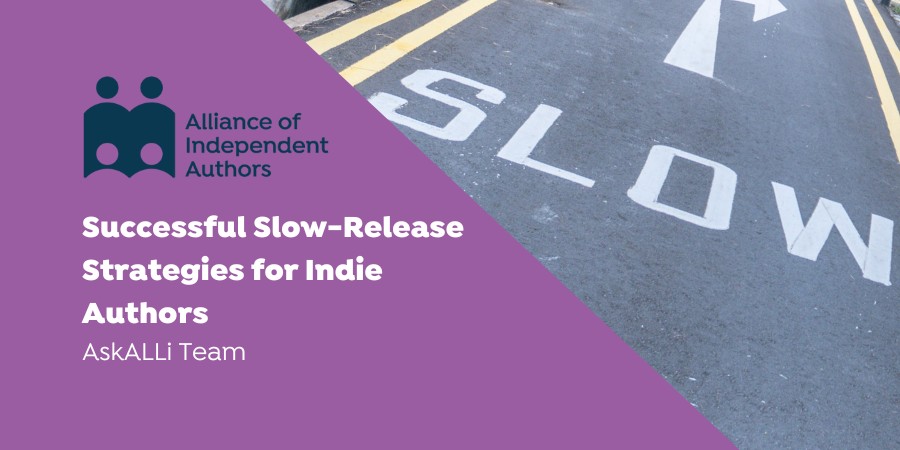ALLi has many members who commit to a rapid release strategy to keep their readers engaged, with regular books coming to the market several times a year or more. But for those of us writing to a gentler schedule, there's a strategy that might not only help you stand out from the crowd but also build a dedicated fan base over time: slow-releasing books.
In this post, we'll explore the concept of slow-releasing books and how it can work for you, including tips from two ALLi members who have successfully built an indie-author living while slow releasing their work: Literary Fiction and Writing Craft author Roz Morris, and Fantasy and Non-Fiction author Russell Nohelty.
What is Slow-Releasing?
Slow-releasing, doesn't have a firm definition. But, as the term suggests, it's a model that generally involves spacing out the publication of your books over a longer period instead of releasing them in quick succession through what’s known as ‘rapid release’.
The Benefits of a Slow-Release Strategy
The most obvious benefit of slow-releasing is to offer authors a longer period of time to develop and write each book, either in a series or as standalones. This can suit those writers looking to work at a slower pace on each book, either for practical or creative reasons.
But there are other benefits to this slow-burn strategy, such as:
- Engaging Readers: Slow-releasing books can encourage readers to engage more deeply with your work. They have time to savour each book, as well as reflecting on, and potentially discussing with others, the book’s themes and ideas while they wait for the next.
- Encouraging anticipation: Releasing books over time allows authors to cultivate a dedicated readership and build anticipation for their work, creating a sense of rarity over each publication. This slower engagement can lead to loyal fans who eagerly await your next release.
- Building a Bigger Buzz: By promoting each release individually, you can create a sense of excitement and anticipation around each book that builds over several months. Longer time scales can allow you the space to engage at events or with partners across a longer period to promote each individual work in depth, without the pressure of the next book launch coming up.
- Avoiding burnout: Rapid release schedules can be very demanding on an author’s time, creativity, and emotional wellbeing. It’s not unheard of for a rapid-release series to run out of steam before the end, as the author finds they need a break from the process. Slow release may suit you if this is a potential risk.

Photo by Rayson Tan on Unsplash
The Challenges of a Slow-Release Strategy
Slow-releasing books can be a rewarding strategy for self-published authors, but it's not without its challenges for you as a writer, and for your readers.
Understanding the challenges to manage expectations and put mitigations in place is key.
Some of the obstacles you might encounter when adopting the slow-release approach include:
- Delayed Gratification: One of the most significant challenges of slow-releasing is the need for patience from your readers. Readers may find it frustrating to invest time in your book, particularly in a series, only to wait months or even years for the next to be published. This is particularly true of some popular fiction genres, such as crime or romance.
- Balancing Series Complexity: If you're writing a series, managing the complexity of the storyline and character arcs over an extended release schedule can be challenging. Authors must ensure that each book maintains continuity and satisfies reader expectations.
- Market Trends and Competition: The publishing industry is dynamic, with trends and reader preferences changing regularly. Slow-releasing authors may find they need to adapt their work to stay relevant in a constantly evolving market. This can be complex when the previous books in a series may have been released years earlier.
- Reader Memory and Interest: Readers may lose interest or forget about your series between releases. Keeping them engaged and excited about your work over an extended period can be challenging, especially if they have a lot of other books in your niche vying for their attention.
Tips for Successful Slow-Releasing for Indie Authors
We’ve covered the benefits and potential pitfalls of slow-releasing books, and you’re still reading… so let's explore some tips to make this strategy work for you:
- Plan Ahead: Create a release schedule that spans months or even years. Place milestones along the way, not only for your writing, but for your long-term marketing and reader engagement activity. This will help you stay organized and continue to build anticipation with your audience for each book.
- Engage Your Readers: Between launches, communicate and interact with your readers on social media, through newsletters, or on author platforms like Goodreads. Share your progress, behind-the-scenes insights, cover design options, new character names and snippets from upcoming releases to keep them engaged and build anticipation. And don't forget in person engagement too, from signings, conferences or events.
- Edit and Design Professionally: When slow-releasing books, you will gain additional time between each release. Utilise the headspace to work hard on the quality of your final book, making sure it is professionally edited and has an eye-catching cover design that targets your niche. Quality matters, particularly when you are offering quality over quantity on a slow release schedule. It's what will build readers' trust that your next book will be worth the wait.
- Undertake Rich Promotion: Take time to plan and deliver a rich set of promotional activities for each book ahead of and during release. Use book launch strategies, such as book tours, giveaways, and influencer engagement, to generate and maintain interest. With time between releases, you can have peaks of additional promotion at key points between book launches.
- Collect Feedback: Encourage readers to leave reviews and provide feedback on your work to inform your next release. Use this input to improve your writing and storytelling and show you are listening to your readers.
- Offer Consistency: You may be releasing more slowly, but this doesn’t mean you can release any time you like. To build trust with your audience, you ideally need to plan and communicate upfront how regularly and when you will release. A good approach is to select a 12-month cycle, so readers know how long they are waiting for their next fix.
- Be Patient: Slow-releasing books requires patience. Don't be discouraged if you don't see immediate results. Building a dedicated readership takes time and, just as with rapid release, you may be a few books in before you see real benefits. With a longer strategy, this means even more patience is needed to get to your goal.

Roz Morris
Indie Author Interview: Roz Morris
ALLi interviewed indie author Roz Morris to find out about her journey into publishing and how slow-releasing books has been not just a strategy but a necessity for her writing style.
I’m Roz Morris. I write literary fiction, creative non-fiction and writing-craft books. I’m also a writing coach and book and magazine editor (And I edit the ALLi magazine, The Indie Author). You can find out more about me on my website rozmorris.org or follow me on X (Twitter): @Roz_Morris
I worked in publishing before I became an indie author. I ran the editorial department of a small imprint, and while I was doing that I was querying agents with my own work. By a lucky accident I found myself ghost-writing novels for highly successful genre authors, which was a brilliant apprenticeship. I worked with top editors and learned loads about the requirements of different commercial markets.

Three Novels by Roz Morris
I also discovered my real voice and my true writing vocation. It wasn’t genre fiction.
Although I sometimes wrote four novels a year, my heart was in literary. I experimented with self-publishing in 2009 by putting out a book on writing (Nail Your Novel), based on my experience mentoring authors for a literary consultancy. Because of my publishing experience, I knew the editorial and production stages. When I used them on my own book, I felt I’d found myself. The writing book did well, so I took the plunge with my first novel, My Memories of a Future Life, in 2011.
Now, in 2023, I have three novels, one travel memoir and four books on writing craft. On average, that’s probably less than one release a year – which I guess means my output is in the slow-release category.
Why I chose slow-releasing books
My publishing frequency is dictated entirely by the nature of the books. They need to take their own time, especially the novels. While I can produce a writing-craft book in a few months, the novels take a lot of research, concepting, playtime and tireless editing. That process is unpredictable.
My most recent novel took seven years, though I published three other books in that time too. The novel before that took only two. It’s a long game. But it’s right for me. I wanted to become a writer because I was inspired by books that were worthwhile and beautiful and original and significant, and that’s what I want to leave in the world.
This publishing schedule is not expected to produce a full-time living, so I do editing and other writing as well. And the variety suits me. It brings refreshing input from other people’s creative worlds. Some of the work I do is on medical journals, which is an interesting reality check. I don’t mind fitting my publishing schedule around work for others.
Keep in touch with your readers… and consider what you have to offer that they may also enjoy
If you're releasing books infrequently, there's a danger that your readers might forget about you, so stay on their radar.
I use my newsletter, and send updates every month. Although my progress on book projects is slow, there are other things I can share about creative life. It also helps that I have a very photogenic horse, so that's a good source of monthly stories. Keep in touch with your readers, tell them you're still active and creating – and get inventive with the way you do it.
Listen to your heart when planning your release strategy
You probably already know if slow release is right for you. Your heart tells you to obey the work. It’s not a strategy so much as an artistic necessity. You let the book tell you when it’s ready. That doesn’t mean you can’t set publishing goals, but I’ve learned not to do that until I’m quite advanced with a book.
I’ve also learned it’s good to have several in progress, if possible. I’m starting another novel and I also have a creative non-fiction collection on the boil, which will probably give me a release next year while the big book finds its feet.
Slow release is like your writing style. It either feels natural to you or it doesn’t.

Russell Nohelty
Bestselling Author Tips: Russell Nohelty
Russell Nohelty is a USA Today Bestselling author of fantasy and non-fiction. He is the publisher at Wannabe Press and The Author Stack, co-founder of The Future of Publishing Mastermind, and co-creator of the Author Ecosystem.
Russel has written over 40 novels and several non-fiction books. He has been releasing books since 2011, independently since 2014, and has been a six-figure creator since 2017.
Here, Russell shares his tips for identifying the release strategy that would be right for you.
Russell’s top tip for slow-releasing books
Since you aren't releasing often, you need to make the most of every launch, and build enough momentum to carry you through to the next release.
One of the best ways to facilitate this is through Kickstarter. Kickstarter allows you to maximize the revenue for your launch from your most ardent fans, and then use that money for other marketing efforts between releases. I generally use Kickstarter or landing pages to release books, and none of my novels are on retailers right now.
Consider your “author eco-system” to find success
We live in a world where almost any type of writer can find success, but you have to go searching for what works for you. It is very possible, though, especially if you lean into your “author ecosystem” – your natural skills and tendencies.
Depending on your ecosystem, the way to extend your launch for slow-release might look different.
If you're a Forest, you'll probably enjoy building a community for your work through some sort of Facebook/Mighty Networks/Circle/Ream community.
If you're a Grassland, you can put out supplementary material or build a membership to help you between launches through Patreon/Ream/Substack.
As a Tundra or Aquatic, you'll probably want to launch other products like pins or other merch to help maintain momentum.
As a Desert, you'll almost assuredly be optimizing advertising (though usually Deserts aren't slow releasers).
One technique that didn’t work out as planned…
I have not had much success launching slowly through retailers. I have found a lot of success at conventions, through subscriptions, crowdfunding, and with landing pages, but not retailers. Almost all my sales are direct to readers.
To Sum Up
Slow-releasing books can be a smart strategy for self-published authors looking for a slow-burn approach to book sales.
By focusing on quality, engaging readers over time, and building anticipation, you can create a loyal fan base that supports your writing journey for years to come. It can also be a sustainable way to write and release around other work and commitments.
However, it's essential to be aware of the challenges that come with this approach. Success often requires a combination of patience, adaptability, and a commitment to engaging with readers across a longer period of time.
And if you have read this blog and think slow release isn't for you… look out for a new post coming soon exploring the pros and cons of rapid release for indie authors!
 Find Out More
Find Out More
Whether you are considering slow or rapid release, finding your audience ahead of time is critical to indie author success. Catch up on our recent Ultimate Guide to Finding Your Readers for tips to and guidance to do just that.







By releasing books at a more measured pace, you give readers the opportunity to fully engage with each installment, fostering a deeper connection with your characters and storylines.
My release schedule is based on my writing and editing pace, so a long term schedule wouldn’t work for me. The rest of the advice, however, is helpful.